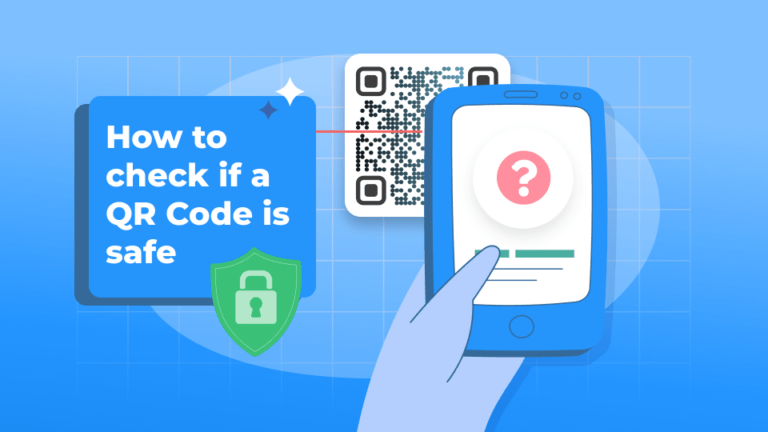Are QR Codes Safe? What You Need to Know About Scanning Smart
Published on March 22, 2025

In today’s digital age, QR codes have become an essential tool for everything from making payments to accessing websites and promotions. Whether you’re scanning a code on a product, restaurant menu, or flyer, it’s clear that these little squares have revolutionized the way we interact with information. However, with their growing use comes a valid concern: Are QR codes safe? Can you trust that what you’re scanning isn’t leading you into a potential scam or malware trap? Let’s dive into the world of QR codes, their potential risks, and most importantly, how to scan smart and stay safe. 1. What Are the Risks of Scanning QR Codes? While QR codes themselves are not inherently dangerous, malicious actors can use them to trick users into visiting harmful websites or downloading malware. Here are some of the risks involved: Phishing Scams: Malicious QR codes may direct you to fake websites that look like legitimate pages (such as banking sites or online shopping platforms). Once there, scammers can steal your personal information, passwords, or credit card details. Malware Installation: A malicious QR code can prompt you to download an app or file that contains viruses, ransomware, or other forms of malware that can compromise your device. Unwanted Redirects: Scanning a code might take you to an unexpected page, such as a pop-up ad or malicious software download prompt. In some cases, this could lead to fraudulent charges or data theft. 2. How to Spot Dangerous QR Codes Not all QR codes are harmful, but it’s important to be vigilant when scanning, especially when you come across codes from untrusted sources. Here’s what to look out for: Strange or Unfamiliar URLs: Always check the URL you’re directed to after scanning a QR code. If it looks suspicious, has strange characters, or seems unrelated to the source (for example, a random link appearing on a restaurant menu), don’t proceed. Tampered Codes: Be wary of QR codes that have been tampered with or placed over existing codes (like on billboards or flyers). Hackers can place their own malicious codes on top of legitimate ones to trick you into scanning. Codes in Unlikely Places: QR codes that appear on flyers or posters in public spaces—especially if the source is unknown—are red flags. Always ensure that the QR code leads to a trustworthy destination before scanning. 3. Safe QR Code Scanning Tips While QR codes are incredibly useful, it’s essential to practice smart scanning habits to keep yourself safe. Here are some key tips: Use Trusted QR Code Scanners: Many modern smartphones come with built-in QR code scanners in their camera apps. These are often more secure than third-party apps, as they are designed with safety in mind. Additionally, these native scanners often show you a preview of the link before you visit the website. Avoid Scanning Suspicious Codes: If you receive a QR code in an unexpected email, text, or even on a flyer in an unfamiliar location, don’t scan it until you can verify its source. Check the Link Before Clicking: After scanning, pause for a moment and examine the link or website you are directed to. If it’s a website that asks for personal information like passwords or credit card details, be extra cautious. Update Your Device and Apps Regularly: Keep your smartphone’s software and apps up to date to ensure that security vulnerabilities are patched. This will help protect your device from being compromised by malicious links or downloads. 4. How to Protect Your Personal Data When Scanning Staying safe while scanning QR codes isn’t just about avoiding scams—it’s also about protecting your personal data. Here’s how you can further safeguard your information: Avoid Entering Sensitive Information: When scanning QR codes, don’t enter sensitive information, such as passwords or credit card numbers, unless you are 100% sure the destination is legitimate. Use a VPN: A Virtual Private Network (VPN) encrypts your internet connection, protecting your data from potential hackers when you’re connected to unsecured networks. This can add an extra layer of security when scanning QR codes in public places like cafes or airports. Be Wary of Public Wi-Fi: Public Wi-Fi networks are often unsecured, making it easier for hackers to intercept your data. Always avoid scanning QR codes when connected to these networks, or use a VPN to protect your information. 5. Benefits of QR Codes in Marketing and Payments Despite their risks, QR codes remain a highly effective and convenient tool for businesses and consumers alike. They offer numerous benefits: Convenience: QR codes allow for quick access to websites, payment portals, and promotional offers without the need for typing out URLs or waiting for a webpage to load. Touchless Payments: Especially in the post-pandemic world, QR codes have become essential for contactless payments, allowing customers to pay with their phones, reducing physical contact. Engagement and Tracking: For marketers, QR codes provide valuable analytics and insights, helping businesses track consumer behavior, optimize campaigns, and engage customers with personalized offers. 6. How to Scan QR Codes Safely To wrap up, here’s a quick checklist for scanning QR codes securely: Only scan codes from trusted sources (businesses, reputable platforms, etc.). Preview the URL before proceeding to ensure it’s legitimate. Use secure, updated apps or built-in QR scanners from your phone’s camera. Avoid entering personal information unless you’re certain the website is safe. Don’t scan QR codes in public places unless you know the source is trusted.
Conclusion
QR codes offer immense convenience, but just like any digital tool, they come with certain risks. By being cautious and adopting smart scanning habits, you can enjoy the benefits of QR codes while keeping your personal data safe. As QR codes continue to play a major role in everything from marketing to payment systems, staying informed and vigilant is the best way to ensure you’re scanning smart—and staying secure.